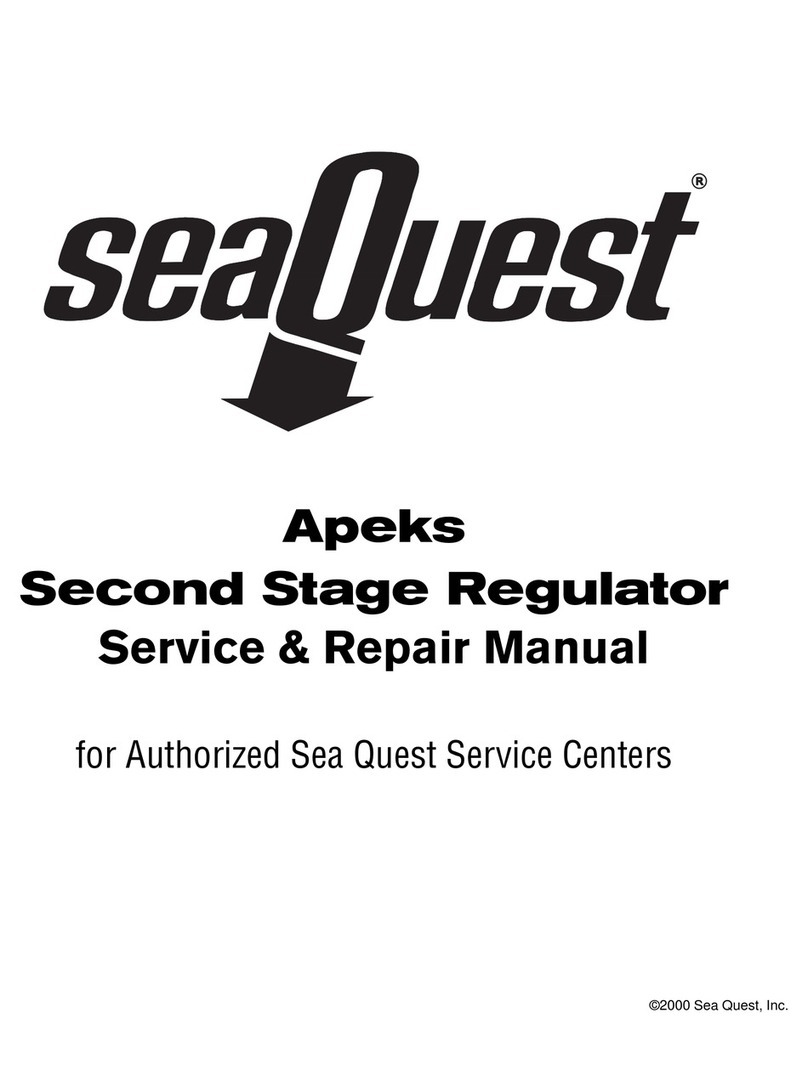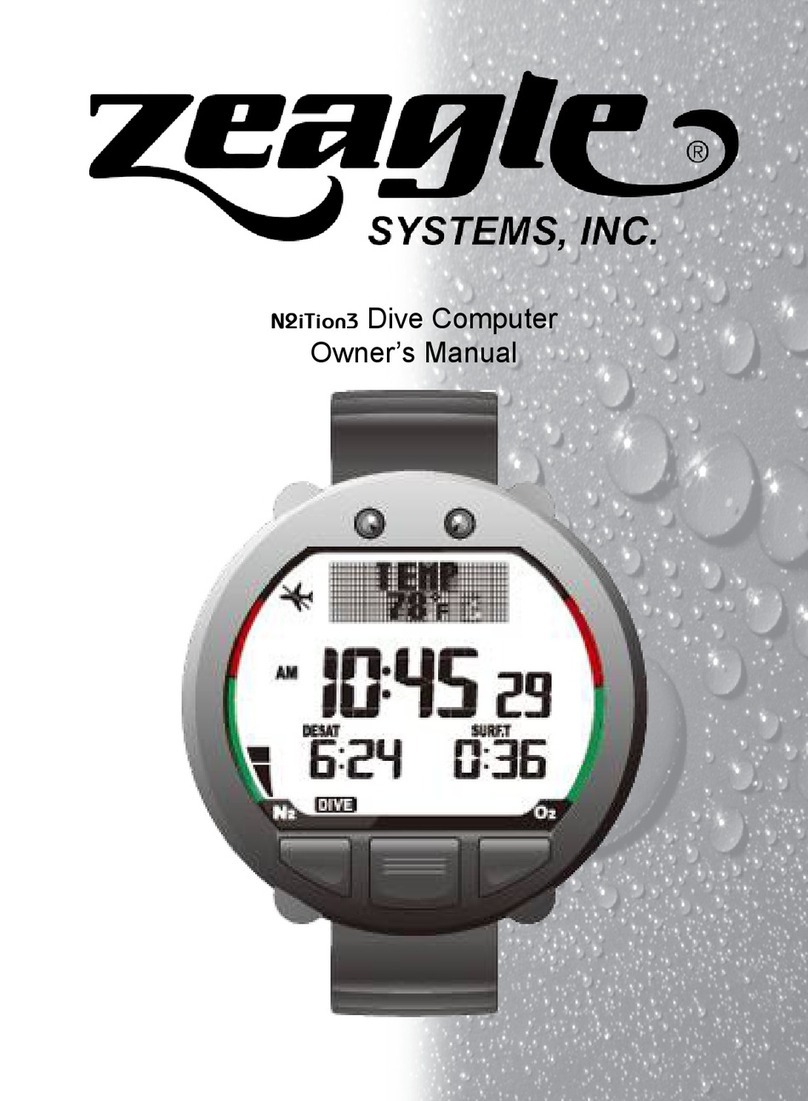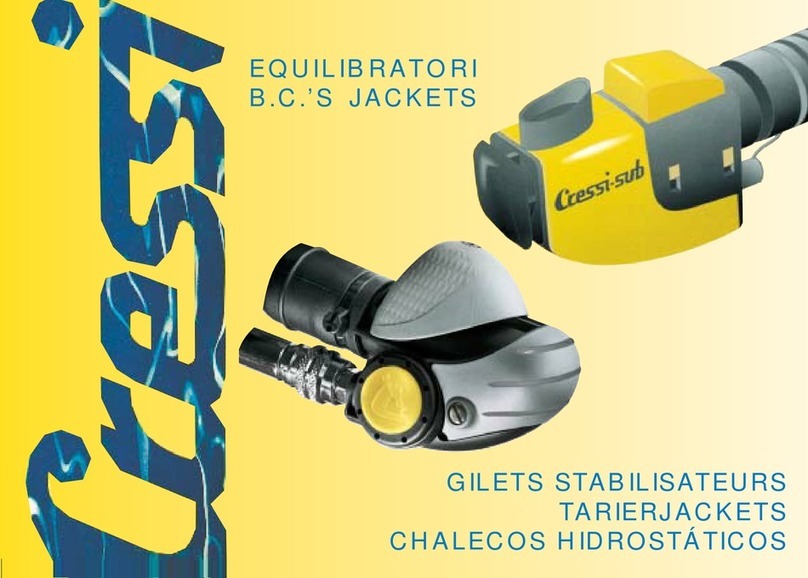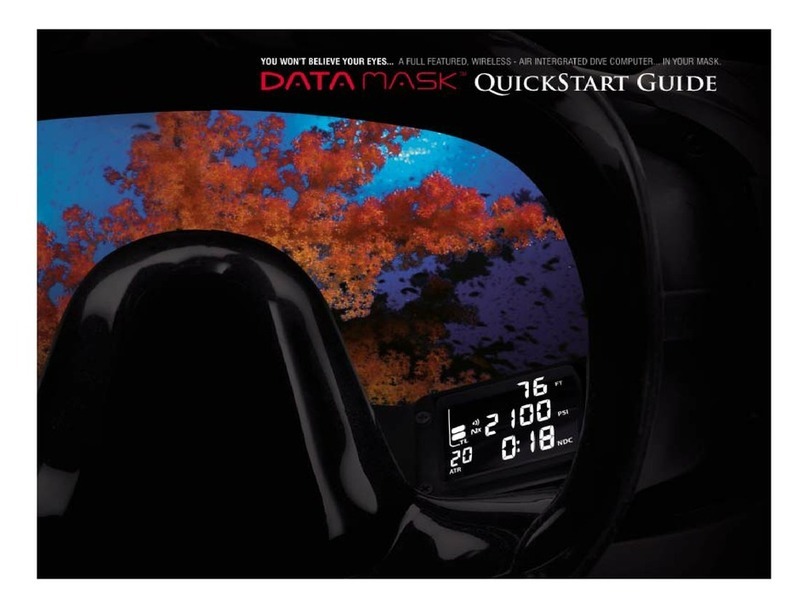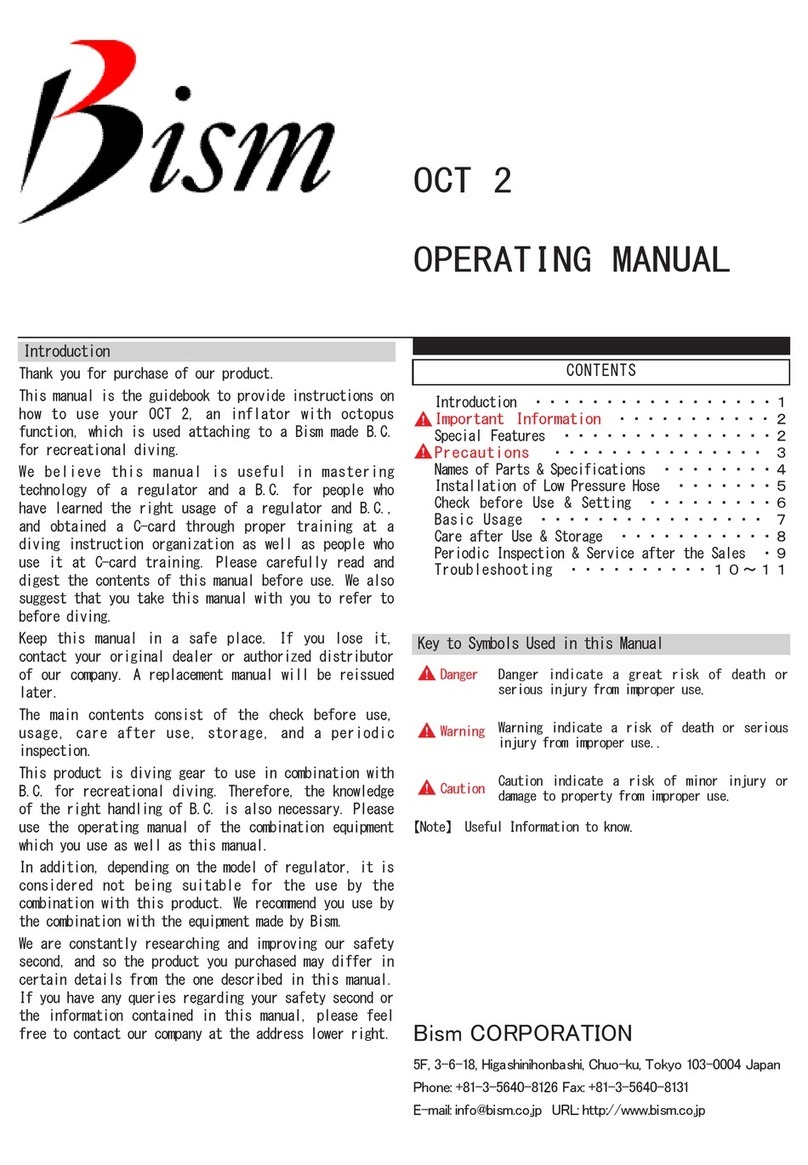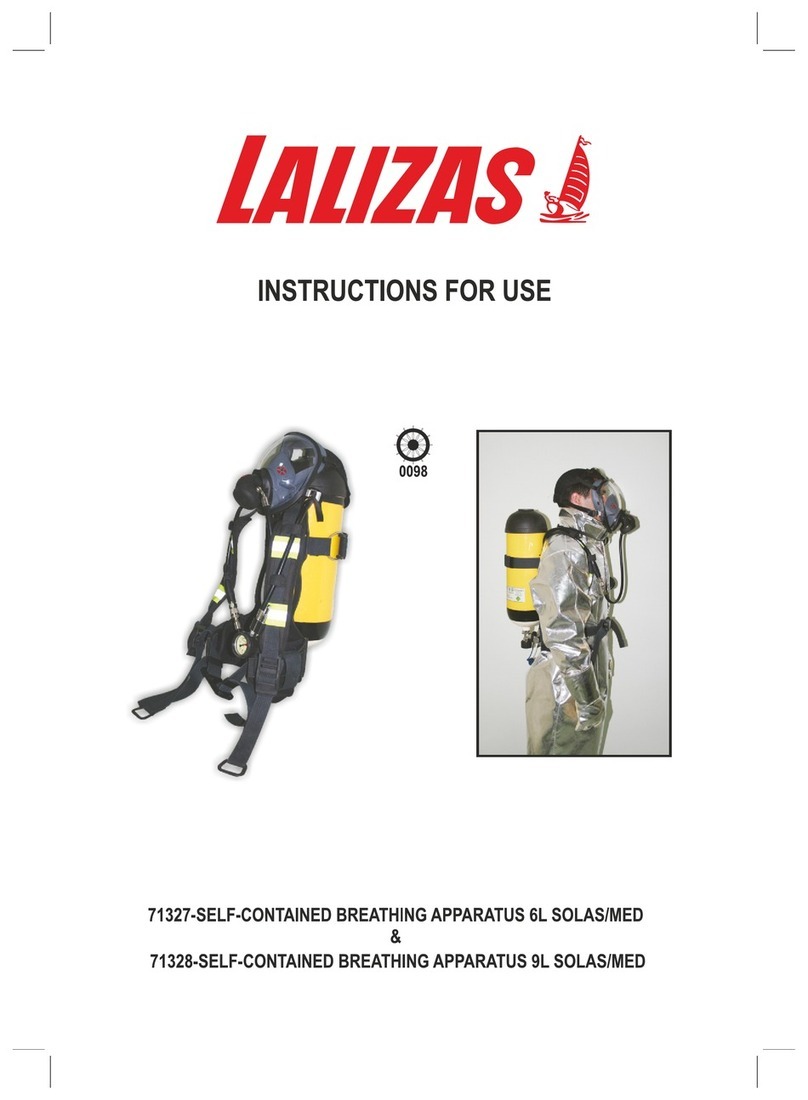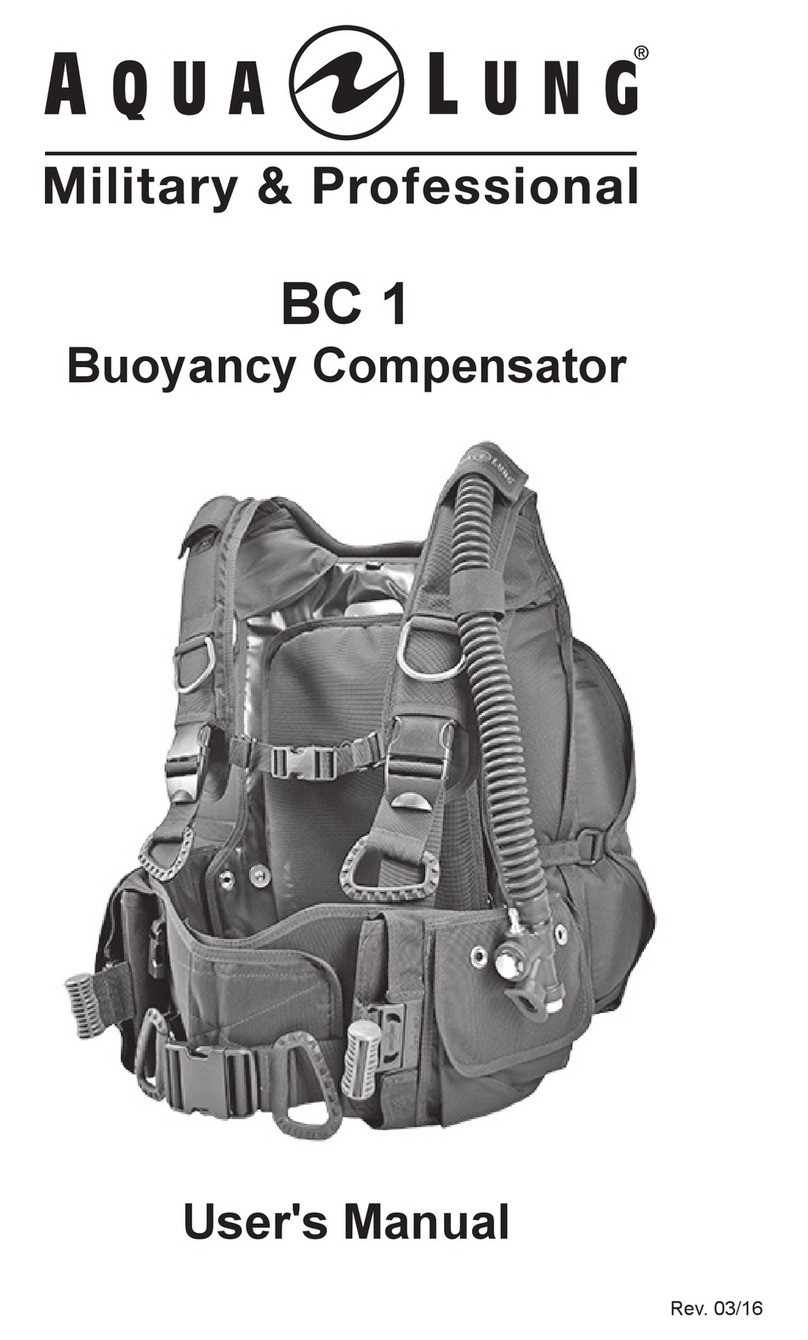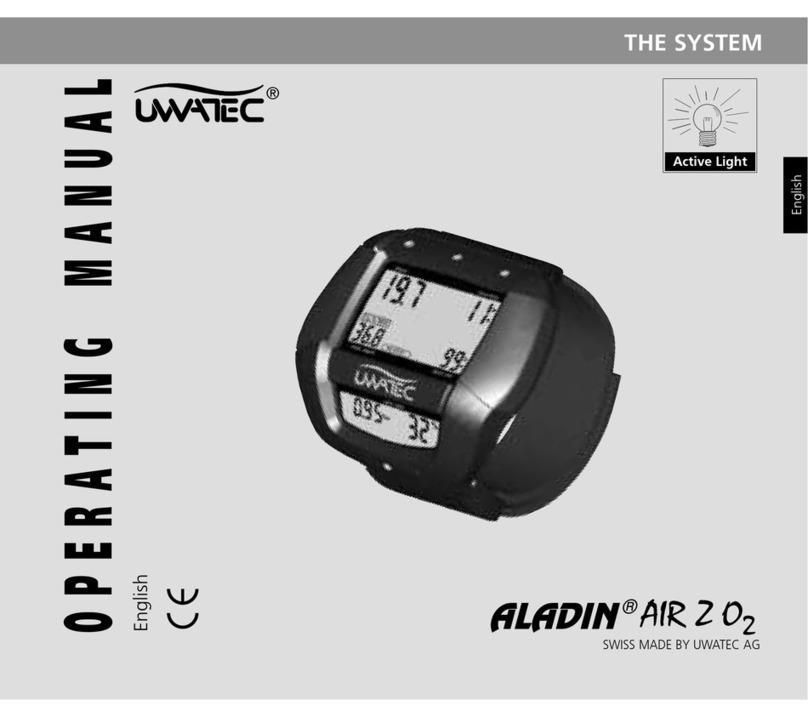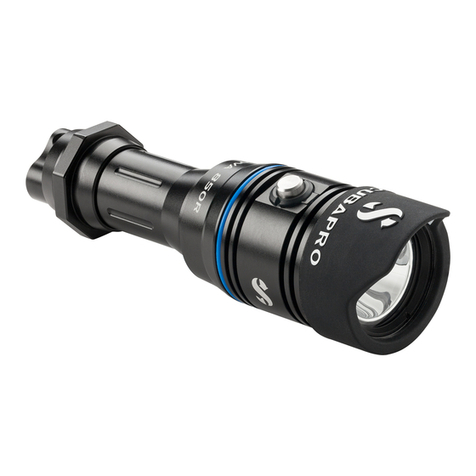Sea Quest Pro QDi3 User manual

Pro QDi3
Buoyancy Compensator
Owner’s Manual

Pro QDi3 BC Owner’s Manual 1
WARNINGS indicate a procedure or situation that
may result in serious injury or death if instructions
are not followed correctly.
CAUTIONS indicate any situation or technique
that will result in potential damage to the
product, or render the product unsafe if
instructions are not followed correctly.
NOTES are used to emphasize important
points, tips and reminders.
WARNING: This manual provides essential instruction for the
proper tting, adjustment, inspection and care of your new BC.
Because Aqua Lung BC’s utilize patented technology, it is very
important to take the time to read these instruction in order to
understand and fully enjoy the features that are unique to your
specic model. Improper use of this BC could result in serious
injury or death.
Copyright Notice
Warnings, Cautions, & Notes
This manual is copyrighted, all rights reserved. It may not,
in whole or in part, be copied, photocopied, reproduced,
translated or reduced to any electronic medium or machine-
readable form without prior consent in writing from Aqua
Lung International. It may not be distributed through the
internet or computer bulletin board systems without prior
consent in writing from Aqua Lung International.
©2006 Aqua Lung International
Pro QDi3 BC Owner’s Manual
pn 18347 rev. 11/06
Pay special attention to information provided in warnings,
cautions and notes that are accompanied by one of these
symbols:

2Pro QDi3 BC Owner’s Manual
CONTENTS
QUICK REFERENCE 3
SAFETY INFORMATION 4
General Precautions & Warnings 4
BASIC SETUP 6
Attaching the MP Hose to the First Stage 6
Securing the BC to the Cylinder 7
Threading the Cylinder Band 8
Double Cylinder Setup 9
Routing and Attaching the MP Inator Hose 10
WEIGHT INTEGRATION FEATURE 12
Weight System - Setup & Installation 12
Loading the Weight Pouches 12
Weight Pouch Installation 14
Releasing the Weight Pouches 15
Non-releasable Weight 16
DONNING & ADJUSTMENT PROCEDURES 17
INFLATION METHODS 18
Oral Ination 18
Storing the Oral Inator 19
Power Ination with i3 Control Unit 20
DEFLATION METHODS 21
Deation via i3 Control Unit 21
Deation via Flat E-Valve (right shoulder) 21
Overpressure Relief (OPR) via Flat E-Valve 22
SPECIAL FEATURES 23
Knife Attachment 23
Octo Pocket™ 23
Multiport 24
PREDIVE INSPECTION 25
POSTDIVE CARE & MAINTENANCE 26
DEALER INSPECTION & SERVICE 27
SERVICE RECORD 28
WARRANTY INFORMATION 29

Pro QDi3 BC Owner’s Manual 3
QUICK REFERENCE
Accessory
D-rings (5)
Chest Strap
Oral Inator
Swivel Buckle
Pull Knob
SureLock
Weight System
Cummerbund
Waist Buckle
i3 Control Unit
Lever
MP Hose
w/Hose Grip
Knife Attachment
Grommets
Flat E-Valve
Multiport
MP Hose
Hold-down
Traction Pad
Flat E-Valve
Carry Handle
Positioning Strap
Cylinder Band

4Pro QDi3 BC Owner’s Manual
General Precautions & Warnings
Before using this buoyancy compensator (BC), you must receive instruction
and certication in SCUBA diving and buoyancy control from a recognized
training agency. Use of SCUBA equipment by uncertied or untrained
persons is dangerous and can result in injury or death.
Read this owner’s manual completely before attempting to use your
BC, and become familiar with it rst in a controlled environment such
as a swimming pool, in order to weight yourself properly and to become
comfortable with using its many features and adjustments.
Before every dive, perform a complete pre-dive inspection according to
the procedure prescribed in this manual, to ensure that all components
are functioning properly and no signs of damage or leaks are present. If
you nd that your BC is not functioning properly or is damaged, remove it
from service until it can be repaired by an authorized Aqua Lung/SeaQuest
Dealer.
Your BC is not a lift bag. DO NOT use it to bring heavy objects to the
surface. Doing so may cause permanent damage to the BC, and could
also result in serious injury or death due to embolism or decompression
sickness.
In an emergency such as an out of air situation or uncontrolled descent, it
is important to remove and jettison weight immediately. DO NOT depend
solely on using your BC’s power inator to lift you to the surface.
In the event of an uncontrolled, rapid ascent, it is important to immediately
begin venting air from the BC. Continue venting air to slow your ascent rate
if neutral buoyancy cannot be reestablished.
DO NOT inhale from your oral inator. The BC may contain harmful
contaminants or gasses, which could cause suffocation or injury.
Factory prescribed service for this BC must be performed at least once
annually by a factory trained technician who is employed by an authorized
Aqua Lung/SeaQuest Dealer. Annual service consists of a complete
overhaul of the power inator, and a general air leak inspection of the
bladder and valve connections.
Disassembly, repair, or lubrication must not be attempted by persons
who are not factory trained and authorized by Aqua Lung/SeaQuest.
Unauthorized service will render the warranty null and void.
This BC is designed for use with compressed air or Nitrox/EAN (enriched
air nitrox) mixtures not exceeding 40% oxygen. Any use of gas mixtures
with increased oxygen content or the addition of helium or other
substances may cause corrosion, deterioration and/or premature aging
of the BC leading to component failure of the metal and rubber parts.
The component failures could lead to a loss of buoyancy control and/or
pressure integrity of the BC resulting in injury or death. Non-standard
breathing mixtures may also present a risk of re or explosion. The use
of Nitrox/EAN requires additional training. Failure to observe this warning
may result in injury or death. Use only nitrogen/oxygen mixtures containing
no more than 40% oxygen.
SAFETY INFORMATION

Pro QDi3 BC Owner’s Manual 5
WARNING: Although this manual provides some basic guidelines
for certain buoyancy control techniques, it is not a substitute for
training from a professional diving instructor. Failure to weight
yourself properly may create a hazardous condition that could
lead to serious injury or death. If you are unsure how to weight
yourself in order to achieve optimum buoyancy underwater and
on the surface, do not dive until you have obtained the necessary
instruction from your diving instructor or an authorized Aqua
Lung/SeaQuest Dealer.
WARNING: A buoyancy compensator (BC) is NOT a life jacket!
It is not designed to provide face-up otation in all situations;
therefore it does not meet U.S. Coast Guard regulations for a
life preserver or personal otation device (PFD). If you become
unconscious in the water without a buddy present to immediately
give assistance, you may suffer serious injury or death from
drowning.
Your buoyancy compensator is primarily designed to help you
maintain neutral buoyancy while in a comfortably balanced,
face-down swimming position underwater. It is also designed
to provide you with otation so that you can rest on the
surface, but it is not designed to function as a life preserver
or personal otation device (PFD). In order to meet U.S.
Coast Guard regulations, a PFD must be designed so that
it automatically rights you to a face-up position and holds
your head out of the water on the surface. The design
characteristics of a personal otation device are different
from those of a buoyancy compensator. The ability of any
otation device to oat you in a face-up position can also
be affected by other diving equipment you wear, including
a cylinder, weight or exposure suit, and whether it can be
inated before you lose consciousness.
For this reason, it is important to always dive with a buddy,
and maintain close proximity with them at all times. Do not
depend on any otation device to hold your face above the
surface in the event that you are rendered unconscious in the
water while diving.
If you have any questions regarding your Buoyancy Compensator or
these instructions, contact your local dealer or Aqua Lung/SeaQuest at:
(760) 597-5000

6Pro QDi3 BC Owner’s Manual
3. Check to ensure the o-ring is
present and in good condition,
and screw the threaded end of
the hose into the port. Tighten to
40 in/lbs (46 kg/cm) with a 9/16"
wrench.
Note: The terms “hook”, “loop” and “hook & loop” are used through-
out this manual. Hook & Loop is commonly known as Velcro®,
which is a trademarked brand of hook & loop. Many of the BC’s
components have hook & loop attachments, including the waist-
band, cylinder bands, and weight pouch aps.
2. Remove the port plug
from a MP port on the
regulator using an appro-
priately sized wrench.
WARNING: DO NOT connect the inator hose to a high pressure (HP)
port (greater than 200 psi / 14 bar). This may cause the hose to burst
when pressurized, which can result in serious injury. If you are un-
sure which regulator port is medium pressure (MP) or high pressure
(HP), consult your regulator owner’s manual or your dealer before
attaching the hose.
BASIC SETUP
Aqua Lung / SeaQuest recommends that you bring your
buoyancy compensator, together with your regulator, to your
authorized dealer for the installation of the MP inator hose and
other accessories. The retailer can also answer any questions
you may have pertaining to the information in this manual.
If it is not possible to return the BC with your regulator to your
authorized dealer, you may install the MP quick disconnect
inator hose by carefully performing the steps in the following
procedure.
1. Remove the inator hose from the i3.
Attaching the MP Hose to the First Stage

Pro QDi3 BC Owner’s Manual 7
Note: BC cylinder bands adjust for all standard cylinder diameters:
6.9" (17.5 cm), 7.25" (18.5 cm), and 8.0" (20.3 cm). The cylinder
bands are properly threaded to the buckles when the BC leaves
the factory. If rethreading is necessary, follow the procedure in the
next section: Threading the Cylinder Band.
1. Remove the free end of the
cylinder band from outer slot on
the buckle.
2. Wet the cylinder band and then slide it over the cylinder
so that the BC is at the desired position in relation to the
cylinder valve. Make sure the cylinder valve air outlet is fac-
ing the back of the BC.
3. While holding the cylinder secure,
pull the free end of the cylinder band
until there is a very tight t between
the pack and the cylinder.
Securing the BC to the Cylinder
4. Close the buckle halfway to
hold the cylinder band taut, and
thread the free end of the band
through the open slot in the end
of the buckle.
5. Pull the cam buckle closed so that it lies at against the
cylinder. Secure the end of the cylinder band with the hook
& loop attachment.
6. Test the tightness by pushing/pulling the back frame and
cradle.

8Pro QDi3 BC Owner’s Manual
Step 4: Insert band
through the inside slot.
Step 5: Insert band
through the outer slot.
WARNING: The cylinder band will initially stretch as it becomes
wet. Always wet the band before making the nal adjustment; apply
enough tension to ensure that the cylinder is completely secure. Test
this connection before every dive. If the cylinder slips free from the
BC during the dive, you may lose your air supply, which could lead
to serious injury or death.
Threading the Cylinder Band TOP VIEW
Step 3: Insert band through
the metal D-ring, then
through the middle slot.
Step 1: Firmly grasp the metal
D-ring with your left hand.
Step 2: While rmly holding the
metal D-ring, rotate the buckle
back towards the webbing. The
buckle should form an angle with
the metal D-ring as shown in the
top view.

Pro QDi3 BC Owner’s Manual 9
NOTE: This nal threading step is done when the BC is secured
to the cylinder (refer to step 4, p. 7). Close the buckle halfway to
prevent the webbing from slipping and thread the free end of the
band through the open slot in the end of the buckle.
WARNING: The use of oversized twin set ups can lead to a dan-
gerous situation underwater, including your inability to achieve
positive buoyancy, or structural failure of the backpack. Such
an event while diving may separate you from your primary air
source, and could lead to serious injury or death.
Double Cylinder Setup
The Tank Band Kit for Twin Cylinders (P/N 427042) allows
mounting of twin cylinders to the Pro QDi3, sizes ML, L, XL
and XXL only. Please see mounting instruction provided with
the kit.
Before adapting your BC for use with double cylinders, it
is important to compare the lift capacity of your particular
BC size (refer to the information on BC tag) and model with
the buoyancy specications of the cylinders, the amount of
weight you will carry, and the type of exposure suit you will
wear. When fully charged and worn together as doubles,
some cylinders may create enough negative buoyancy to
counteract the amount of lift your BC can provide. At depth,
this can lead to a dangerous situation if your wetsuit becomes
compressed and you can no longer achieve positive buoy-
ancy by jettisoning weight.
Additionally, the structure of the back pack will not support
the weight of an oversized double cylinder set up. The BC
may only be used with standard aluminum (maximum 80
cf/10 litre) or steel (maximum 100 cf, 3,500 psi) tanks. High
volume, low pressure steel tanks can be especially hazard-
ous when worn as doubles, due to their weight and buoyancy
characteristics.

10 Pro QDi3 BC Owner’s Manual
Routing & Attaching the MP Inator Hose
1. After attaching the BC and regulator to a
cylinder, make sure the bladder is completely
deated (see Deation Methods, p. 21).
2. Route the MP hose down
the back of the BC along the
cylinder and through the hook
& loop hold-down. If needed,
adjust the hook & loop hold-
down to the desired size.
4. Remove the dust cap on
the quick disconnect plug
on the i3 control unit.
5. Grab the hose grip between
your thumb and forenger, then
slide the sleeve back.
3. Thread the hose through
the sleeve behind the pocket.
NOTE: Keep the dust cap on while not in use.

Pro QDi3 BC Owner’s Manual 11
NOTE: The Pro QDi3 is equipped with a longer than normal MP in-
ator hose. It is very important to use the inator hose provided with
the BC (if the hose is too short it will not reach the i3 control unit.
Hose lengths are as follows:
XS/S – 27 inches (pn 24827 — red)
M/ML/L – 33 inches (pn 24833 — light blue)
XL – 36 inches (pn 24836 — blue)
XXL – 40 inches (pn 24840 — light gray)
6. Place the tting over the quick dis-
connect plug and rmly push inward
while releasing the hose grip. Check to
ensure the hose is securely attached.
7. To test the connection, slowly open the cylinder valve
and pressurize the regulator. Lift up on the lever and listen
for the ow of air into the BC bladder.

12 Pro QDi3 BC Owner’s Manual
NOTE: The weight pouches are specially pre-formed to t the
contour of your waist. Do not attempt to bend or straighten a
pre-formed pouch.
WEIGHT INTEGRATION FEATURES
The Pro QDi3 features the SureLock™ (SL) weight system.
With the SureLock™ system, weight pouches are secured
with a mechanical locking mechanism, as opposed to a hook
& loop attachment used on other models. The SureLock™
weight system either supplements or replaces a conventional
weight belt. This unique feature allows you to quickly jettison
either one or both of two weight pouches in the event of an
emergency, thereby maintaining better control over your
rate of ascent. The weight pouches can be easily reloaded
into their respective holsters while you are wearing the BC.
This makes the BC much easier to don than other weight-
integrated BC’s that must be fully loaded with weight prior to
donning.
It is very important to read the following instructions, and be-
come thoroughly familiar with the correct methods for install-
ing and releasing weight before you dive with your BC.
Weight System - Setup & Installation
The weight system features two interchangeable weight
pouches which can be lled with either block weights or
“soft weight” (pouches containing lead shot), in increments
of 5 pounds or less. For ease of operation, low-prole block
weight is strongly recommended. Each weight pouch can
hold a maximum of 10 lbs/4.5 kg (20 lbs/9 kg total). The
Large to XX Large can hold a maximum of 16 lbs/7.25 kg
(32 lbs/14.5 kg).
Loading the Weight Pouches
Aqua Lung/SeaQuest recommends that each pouch is loaded
with equal amounts of weight for optimum balance; this will
prevent the tendency to roll to one side during the dive. Also, it
is strongly recommended that each weight pouch is fully loaded
with two separate weight blocks for the standard pouch, or four
separate blocks for the large pouch. For example, if you want
to load a standard pouch with 6 pounds, use two separate 3
pound weights.
1. If the weight pouches are installed in the BC, remove
them by rmly pulling the release handle toward the
center of the waistband (see p. 15, Releasing Weight
Pouches).

Pro QDi3 BC Owner’s Manual 13
Fig. 1
w
b
c
2. Lift up each pouch’s ap (Fig 1a), and lay it back over the
handle (Fig 1b). While holding the pouch fully open, insert
the weight and then close the ap. When each pouch has
been loaded with weight, rmly run your hand over the aps
to securely fasten the hook & loop (Fig 1c).
TOP TOP TOP
TOPTOPTOP
TOP
Installing weight in the large weight pouch
The procedure for loading the large weight pouch is the same
as the standard pouch, except that the large weight pouch
has an upper and lower weight compartment. SeaQuest/Aqua
Lung recommends that the pouches be completely lled with
four separate weight blocks (two per compartment); however,
if you need to partially ll the pouch, load the bottom compart-
ment rst. Use the diagram below for proper weight placement.
(This diagram is also sewn on the weight pouch ap.)

14 Pro QDi3 BC Owner’s Manual
b
a
CAUTION: Aqua Lung/SeaQuest strongly recommends that you do not
attempt to don your BC when it is fully loaded with weight. You may
otherwise risk injury due to muscle strain or a temporary loss of balance.
Surelock™ Weight Pouch Installation
The pouches are installed with the smooth panel facing
outward (pouch ap facing toward the BC).
WARNING: Before every dive, it is important to make sure each weight
pouch is secure, in order to prevent the pouches from falling out.
Involuntary release of both weight pouches underwater can cause a
sudden increase in buoyancy causing a rapid ascent, which could lead
to serious injury or death due to arterial gas embolism, decompres-
sion sickness, or drowning.
To install either pouch, grasp the D-ring or lobe in front of
the female SureLock™ receptacle with your opposite hand
and slide the closed end of the pouch into the opening of
the holster. Insert the male portion of the SureLock™ buckle
(a) into the female receptacle (b) on the BC until you can
hear/feel it click into place.

Pro QDi3 BC Owner’s Manual 15
Releasing Weight Pouches
Unlike a weight belt, which has only one release mecha-
nism, each weight pouch is connected to the BC indepen-
dently of the other and must be released separately. This
provides you with the option of being able to jettison one
pouch at a time, thereby maintaining better control of your
ascent rate in an emergency.
In the event that you need to jettison weight, simply pull
the release handle of each pouch towards the center of the
waist buckle. When the pouch is completely disengaged
from its holster, hold it out and away from your body before
dropping it.
WARNING: Ensure that your weight pouches are not obstructed by
any straps, lines, etc. DO NOT add weight to the BC’s pockets, as
this may interfere with the removal of the pouches in an emergency.
Failure to ditch weight in an emergency may lead to serious injury or
death due to drowning.
WARNING: To avoid injuring other divers, always look below you
before dropping weight.
Note: In addition to becoming familiar with the weight system yourself,
it is very important to explain its function to your dive buddy so that
he/she is equally familiar with it.

16 Pro QDi3 BC Owner’s Manual
Non-releasable Weight
To supplement the releasable weight, the Pro QDi3 is
designed to carry non-releaseable weight in two xed pock-
ets located on the backside of the back pad. The maximum
amount of weight that each pocket can hold depends on the
BC size. Refer to the chart below:
To install weight into the non-releasable weight pockets,
simply disconnect the buckle, open the hook & loop reten-
tion ap, then slide in the weight. Close the hook & loop
retention ap and fasten the buckle.
BC Size Max Wt. Each Pocket Max Wt. Total
XS 3 lbs / 1.3 kg 6 lbs / 2.7 kg
Sm 4 lbs / 1.8 kg 8 lbs / 3.6 kg
Med 5 lbs / 2.3 kg 10 lbs / 4.5 kg
ML 5 lbs / 2.3 kg 10 lbs / 4.5 kg
Lg 5 lbs / 2.3 kg 10 lbs / 4.5 kg
XL 5 lbs / 2.3 kg 10 lbs / 4.5 kg
XXL 5 lbs / 2.3 kg 10 lbs / 4.5 kg
NOTE: Aqua Lung recommends that the non-releasable pockets be
loaded with equal amounts of weight for optimum balance. This will
prevent the tendency to roll to one side during a dive.
WARNING: Because the weight is non-releasable, it must not be
used as your primary source of ballast. A large percentage of
your weight should be in the releasable weight pouches. This will
enable you to achieve positive buoyancy by ditching the weight
pouches in the event of an emergency.

Pro QDi3 BC Owner’s Manual 17
WARNING: The non-releasable weight pockets are intended strictly
for containing non-releasable weight, used in addition to releasable
weight. Do not ll either pocket with weight unless you are certain
you can achieve positive buoyancy at depth by releasing your weight
pouches or weight belt while your BC is completely deated.
DONNING & ADJUSTMENT PROCEDURES
1. Remove the weight pouches from the BC.
2. Loosen and disconnect the chest buckle, waist buckle,
and cummerbund.
3. Ensure that the swivel buckles on both torso straps are
securely fastened. While rmly holding the torso strap
where it connects to the BC lobe, fully extend each torso
strap to its maximum length by pushing straight up on
the slide buckle.
4. While your dive buddy lifts and holds the BC/cylinder be
hind you, place your arms through the BC torso straps
as if you were putting on a jacket.
5. While your buddy continues to hold the cylinder, secure
the cummerbund around your waist (not hips). The best
positioning of the cummerbund is between the hips and
rib cage. The weight of the cylinder should rest on the
lumbar region (lower part) of your back. The tensioning
bands should be fully extended when fastening the
cummberbund at the surface.
6. After the cummerbund is adjusted, connect the waist
buckle and pull the adjustment straps until lightly snug.
7. Connect the chest strap buckle. Pull on the free end of
the strap to tighten. The chest strap should feel comfort
able across the chest; it should not be overtightened so
that it feels restrictive.
8. After your buddy has released the cylinder and the BC
feels comfortably supported on your hips and shoulders,
bend forward at the waist and adjust the torso straps to
a comfortable length by pulling on the torso strap D-rings.
9. If necessary, readjust the cummerbund so that is com-
fortably snug, but not restricting. The cummerbund
should have an overlap of at least 4 inches (10 cm); any
excess can be tucked under the BC.
NOTE: The Pro QD i3 cummerbund has a heavy-duty elastic ten-
sioning bands that allows the cummerbund to compensate for suit
compression while at depth.

18 Pro QDi3 BC Owner’s Manual
INFLATION METHODS
Oral Ination
The oral ination tube is located
under the ap/hook & loop on the
left shoulder of the BC.
To orally inate your BC, pull
down on the mouthpiece to
fully extend the oral ination
tube so that there are no
kinks in the tube.
NOTE: Adjusting the shoulder straps too tightly will transfer the
cylinder weight from the hips to the shoulders, restricting your arm
movement and decreasing comfort.
9. If necessary, readjust the cummerbund so that is com-
fortably snug, but not restricting. The cummerbund
should have an overlap of at least 4 inches (10 cm); any
excess can be tucked under the BC.
Push the mouthpiece
against your lips and exhale
into the mouthpiece.
Immediately after exhaling,
move the mouthpiece away
from your lips to keep the air
from escaping the BC.

Pro QDi3 BC Owner’s Manual 19
Hose should t evenly and at
in pouch under the ap/hook
& loop.
Storing Oral Inator
When the oral inator is not in use, fold the tube and store it
under the ap/hook & loop using the following method.
Using your index nger as a guide, begin
folding the oral inator hose, bending
once under the pouch.
Continue by folding
hose again, using your
index nger as a guide.
Table of contents
Other Sea Quest Diving Instrument manuals
Popular Diving Instrument manuals by other brands
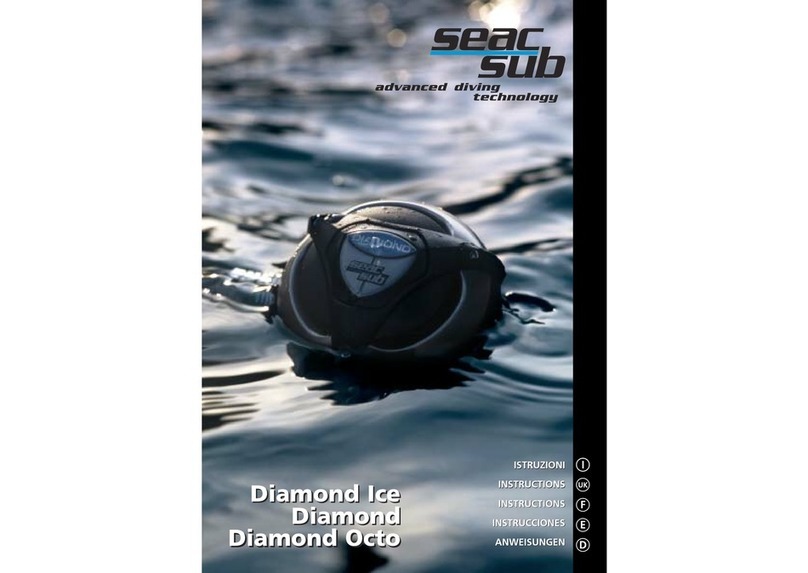
Seac Sub
Seac Sub Diamond instructions
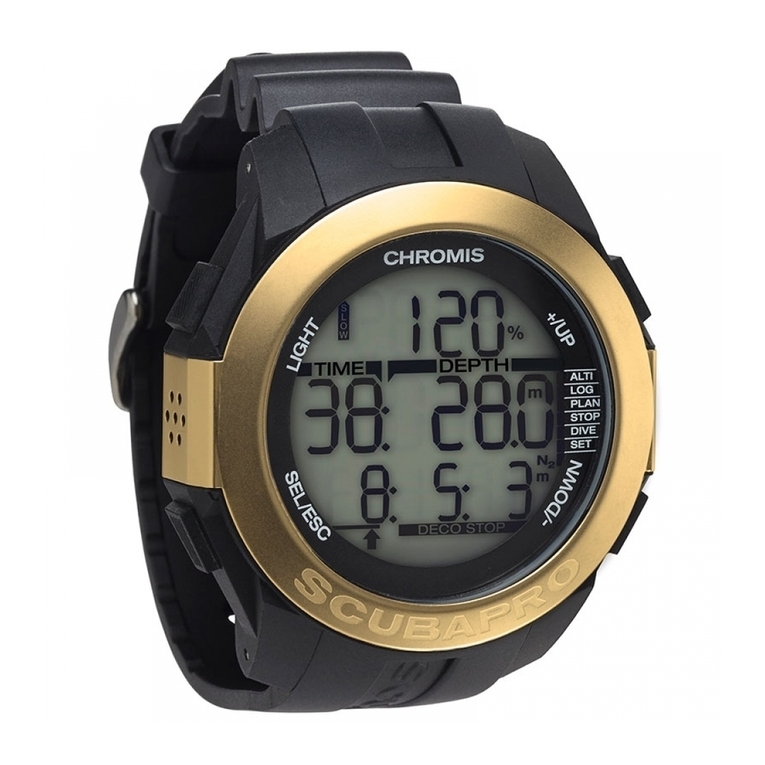
SCUBAPRO-UWATEC
SCUBAPRO-UWATEC Chromis user manual

rEvo Rebreathers
rEvo Rebreathers rEvo III micro FT Use and maintenance manual
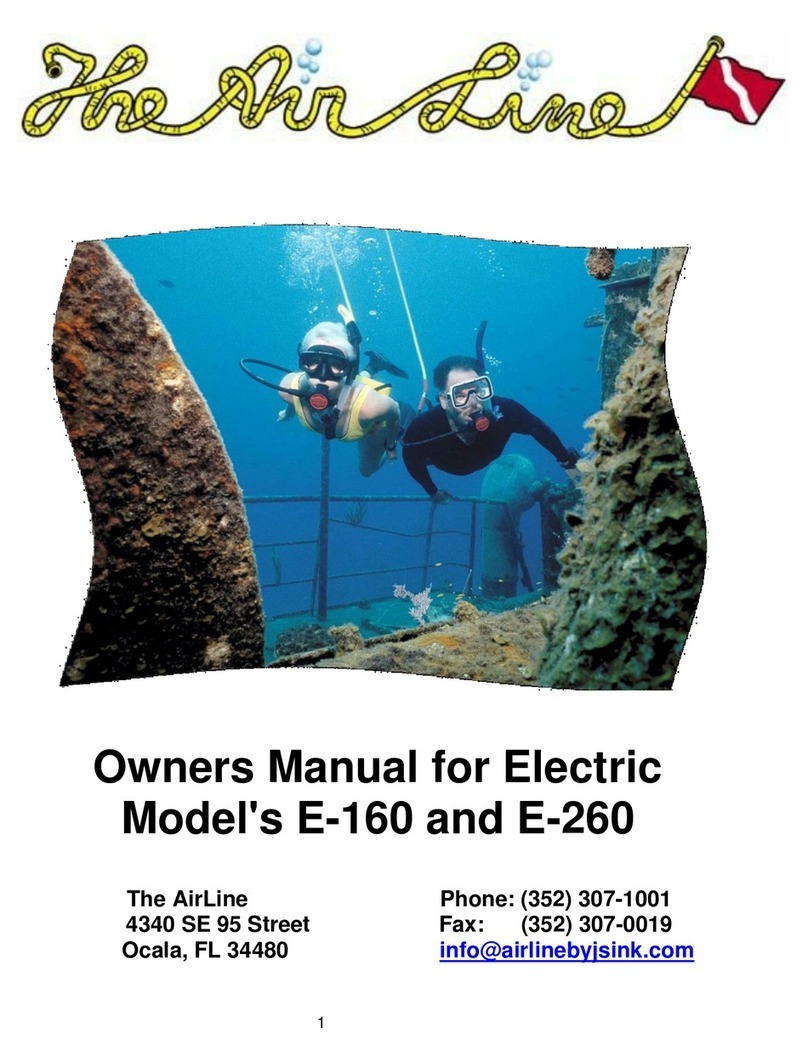
The AirLine
The AirLine E160 owner's manual
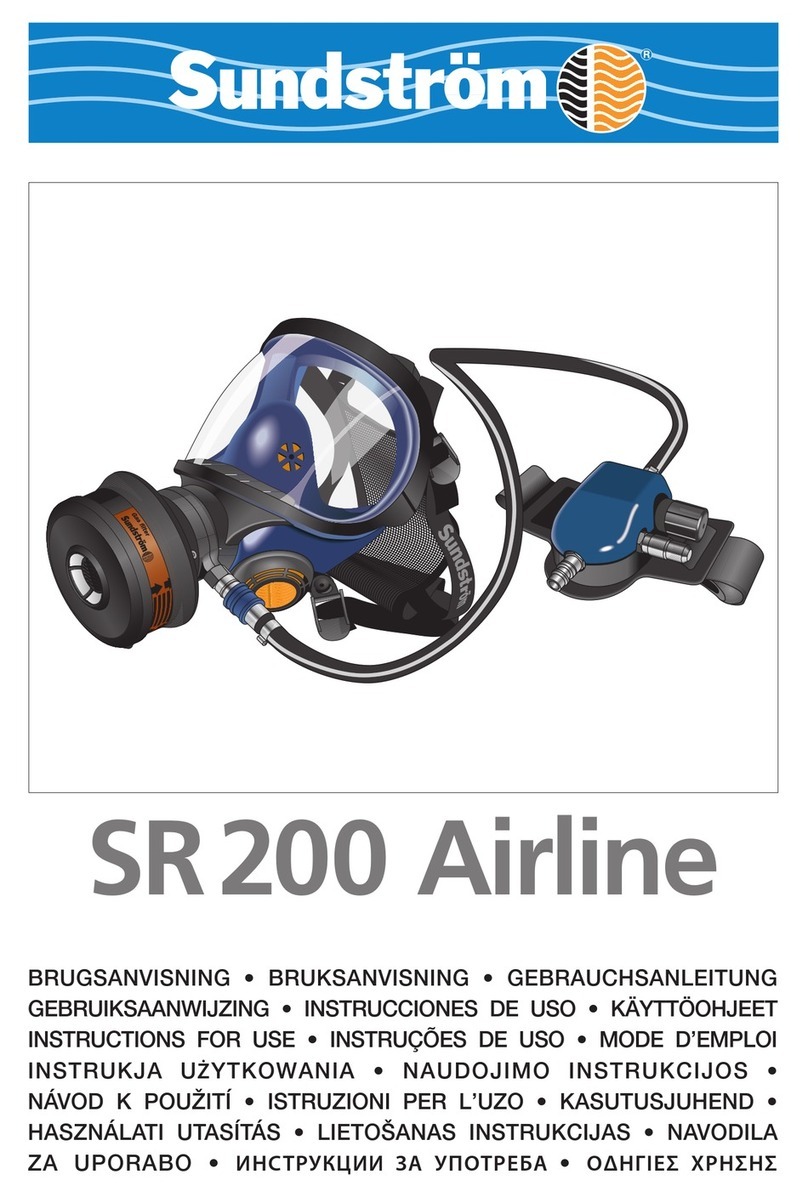
Sundstrome
Sundstrome SR200 Airline Instructions for use
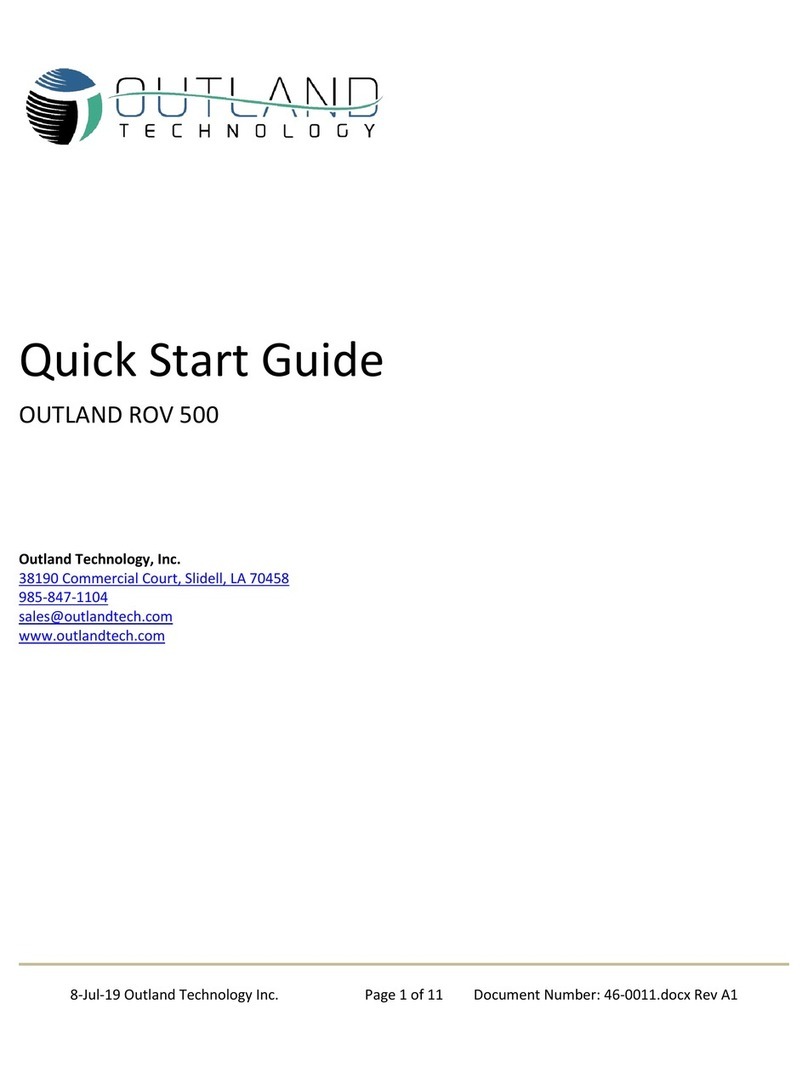
Outland Technology
Outland Technology ROV 500 quick start guide
